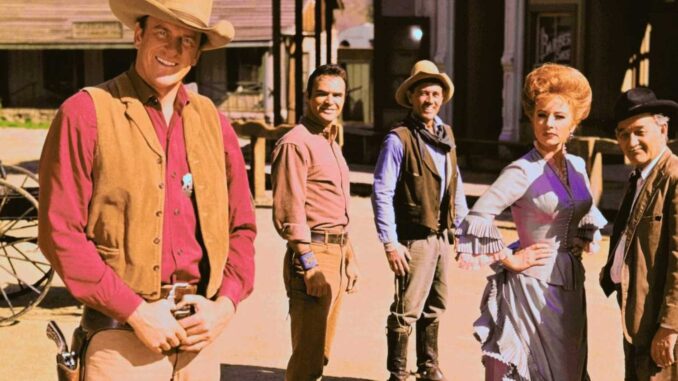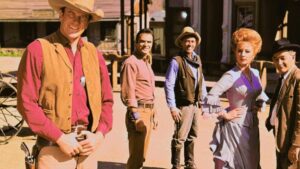
Taylor Sheridan’s Yellowstone has become a cultural phenomenon, capturing audiences with its intense drama, complex characters, and breathtaking portrayal of the American West. However, the show’s success owes much to the legacy of classic Westerns that came before it, particularly one that defined the genre for decades: Gunsmoke. With over 600 episodes spanning 20 seasons, Gunsmoke set the gold standard for Western storytelling on television and left an indelible mark on the genre—a legacy that Yellowstone both draws from and builds upon.

The parallels between Gunsmoke and Yellowstone are evident in their shared themes of justice, morality, and the challenges of frontier life. Gunsmoke, which aired from 1955 to 1975, followed the lives of Marshal Matt Dillon, Miss Kitty, and the residents of Dodge City, Kansas, as they navigated the lawlessness and hardships of the Old West. At its core, the series was about maintaining order in a chaotic and often unforgiving world—a theme that resonates strongly in Yellowstone as John Dutton fights to protect his family’s ranch and way of life.
One of the defining characteristics of Gunsmoke was its emphasis on morally complex characters. Unlike many of its contemporaries, which often portrayed heroes and villains in black-and-white terms, Gunsmoke delved into the gray areas of human behavior. Matt Dillon, though a lawman, was not infallible; he grappled with difficult decisions and the weight of his responsibilities. Similarly, John Dutton in Yellowstone is far from a traditional hero. He is ruthless, willing to cross ethical lines to preserve his family’s legacy, yet his motivations are deeply rooted in his love for the land and his desire to protect it for future generations.
The storytelling approach of Gunsmoke also paved the way for Yellowstone’s episodic yet serialized narrative structure. While Gunsmoke often featured self-contained episodes, it also developed its characters and their relationships over time, creating a sense of continuity and depth. This format allowed viewers to form deep emotional connections with the characters—a hallmark of Yellowstone, where the Dutton family’s intricate dynamics unfold across multiple seasons, keeping audiences invested in their journey.

Visually, Yellowstone owes a debt to the rich cinematography that Gunsmoke popularized during its time. Although the technology of the 1950s and 60s was far less advanced than what is available today, Gunsmoke made the most of its resources to showcase the vast landscapes of the West. The series used its setting as a character in its own right, highlighting the beauty and danger of the frontier. Yellowstone takes this a step further, with its sweeping shots of Montana’s rugged terrain and meticulous attention to detail, creating a visual experience that draws viewers into the Duttons’ world.
Beyond aesthetics and storytelling, Gunsmoke and Yellowstone share a cultural impact that extends beyond television. Gunsmoke helped solidify the Western as a quintessentially American genre, exploring themes of resilience, community, and the struggle for justice that resonated with audiences of its time. Decades later, Yellowstone revitalized interest in the Western genre, proving its relevance in a modern context. By blending traditional Western elements with contemporary issues such as land disputes, environmental conservation, and political power struggles, Yellowstone has redefined what a Western can be for today’s audiences.
Another significant connection between the two series is their exploration of family and loyalty. In Gunsmoke, the characters formed a makeshift family, bound by their shared experiences and commitment to one another. This sense of loyalty and familial bond is mirrored in Yellowstone, where the Dutton family’s unity is both their greatest strength and their Achilles’ heel. The intense relationships between John, Beth, Kayce, and Jamie drive much of the drama, showcasing the complexities of love, betrayal, and the lengths people will go to for those they care about.

The enduring appeal of Gunsmoke and its influence on Yellowstone highlights the timeless nature of Western storytelling. Both shows tap into universal themes of survival, identity, and the search for meaning in a world that is constantly changing. While Yellowstone updates these themes for a 21st-century audience, its success would not have been possible without the groundwork laid by Gunsmoke and other classic Westerns that came before it.
As Yellowstone continues to leave its mark on television, it serves as a reminder of the genre’s enduring power to captivate and inspire. The show stands on the shoulders of giants like Gunsmoke, honoring its legacy while forging its own path. Together, these series demonstrate the richness of the Western genre and its ability to evolve while staying true to its roots, ensuring its place in the hearts of audiences for generations to come.
